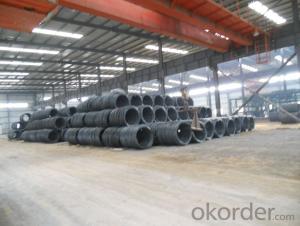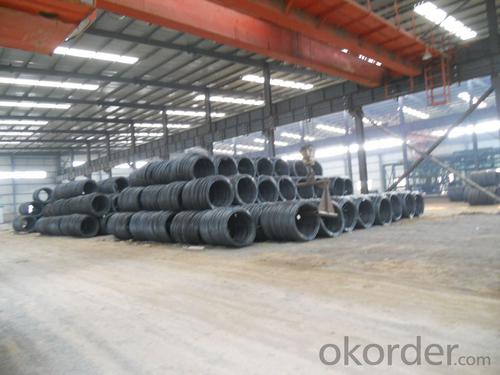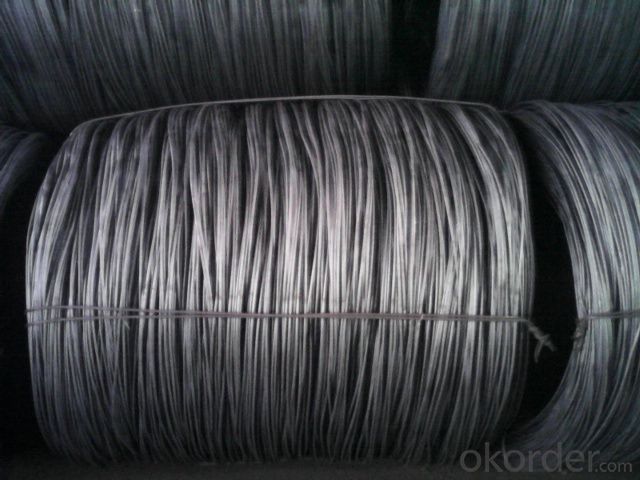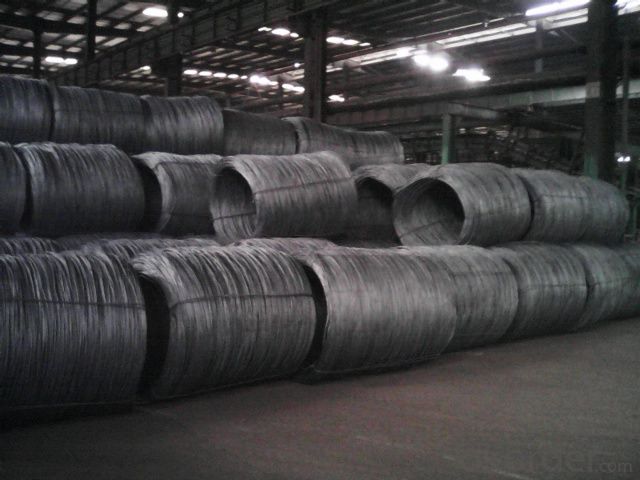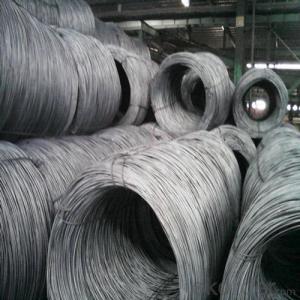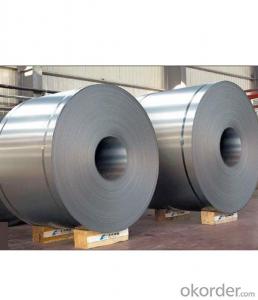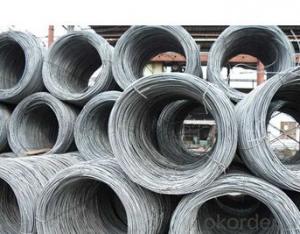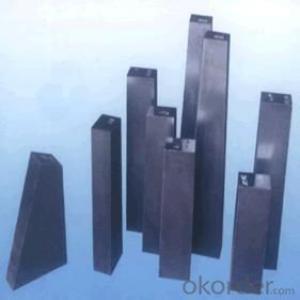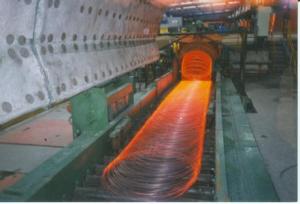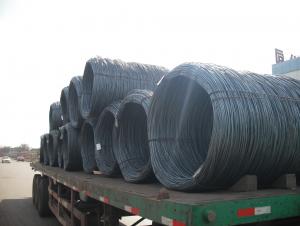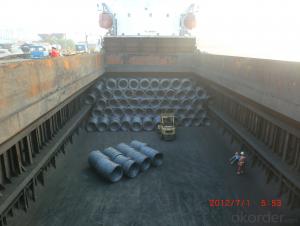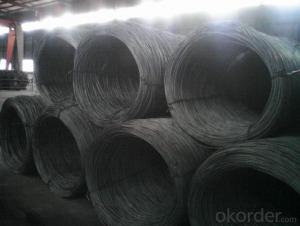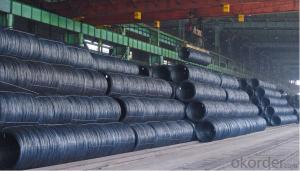Hot Rolled Steel Wire Rod GB/JIS/ASTM/DIN High Qulity
- Loading Port:
- Tianjin
- Payment Terms:
- TT OR LC
- Min Order Qty:
- 500 m.t.
- Supply Capability:
- 30000 m.t./month
OKorder Service Pledge
OKorder Financial Service
You Might Also Like
Specification
Product Description:
OKorder is offering Hot Rolled Steel Wire Rod GB/JIS/ASTM/DIN High Qulity at great prices with worldwide shipping. Our supplier is a world-class manufacturer of steel, with our products utilized the world over. OKorder annually supplies products to European, North American and Asian markets. We provide quotations within 24 hours of receiving an inquiry and guarantee competitive prices.
Product Applications:
Hot Rolled Steel Wire Rod GB/JIS/ASTM/DIN High Qulity are ideal for structural applications and are widely used in the construction of buildings and bridges, and the manufacturing, petrochemical, and transportation industries.
Product Advantages:
OKorder's Hot Rolled Steel Wire Rod GB/JIS/ASTM/DIN High Qulity are durable, strong, and resist corrosion.
Main Product Features:
· Premium quality
· Prompt delivery & seaworthy packing (30 days after receiving deposit)
· Corrosion resistance
· Can be recycled and reused
· Mill test certification
· Professional Service
· Competitive pricing
Product Specifications:
Steel Grade: Q195 Standard: ASTM, GB
Diameter: 5.5mm, 6.5mm, 7mm,8mm,9mm,10mm,12mm,14mm
6.5mm can be drawing into 2mm/8.0mm can be drawing into 3mm
Type: Drawn Wire in Coil, each coil weight about 2MT
Brand Name: N-RIVER Place of Origin: Hebei, China
Chemical Composition:
Please kindly find our chemistry of our material based on Q195 as below for your information
Trademark | Rank | Chemical composition (quality score) % | ||||||
C | Si | Mn | S | P | ||||
| ≤ |
| ≤ | ≤ | ||||
Q195 |
| 0.06-0.12 | 0.30 | 0.25 | 0.050 | 0.045 | ||
Q235 | A | 0.14-0.22 | 0.30 | 0.30-0.65 | 0.050 | 0.045 | ||
Q235 | B | 0.12-0.20 | 0.30 | 0.30-0.70 | 0.045 | 0.045 | ||
Packaging & Delivery of Wire Rod SAE1008B:
Packaging Detail: products are packed in coil and then shipped by container or bulk vessel
Each coil weight: 2-3MT
Delivery Detail: within 45 days after received deposit or LC.
Label: to be specified by customer, generally, each bundle has 1-2 labels
Trade terms: CFR, CIF
FAQ:
Q1: Why buy Materials & Equipment from OKorder.com?
A1: All products offered byOKorder.com are carefully selected from China's most reliable manufacturing enterprises. Through its ISO certifications, OKorder.com adheres to the highest standards and a commitment to supply chain safety and customer satisfaction.
Q2: How do we guarantee the quality of our products?
A2: We have established an advanced quality management system which conducts strict quality tests at every step, from raw materials to the final product. At the same time, we provide extensive follow-up service assurances as required.
Q3: How soon can we receive the product after purchase?
A3: Within three days of placing an order, we will begin production. The specific shipping date is dependent upon international and government factors, but is typically 7 to 10 workdays.
Q4: What makes stainless steel stainless?
A4: Stainless steel must contain at least 10.5 % chromium. It is this element that reacts with the oxygen in the air to form a complex chrome-oxide surface layer that is invisible but strong enough to prevent further oxygen from "staining" (rusting) the surface. Higher levels of chromium and the addition of other alloying elements such as nickel and molybdenum enhance this surface layer and improve the corrosion resistance of the stainless material.
Q5: Can stainless steel rust?
A5: Stainless does not "rust" as you think of regular steel rusting with a red oxide on the surface that flakes off. If you see red rust it is probably due to some iron particles that have contaminated the surface of the stainless steel and it is these iron particles that are rusting. Look at the source of the rusting and see if you can remove it from the surface.
Images:
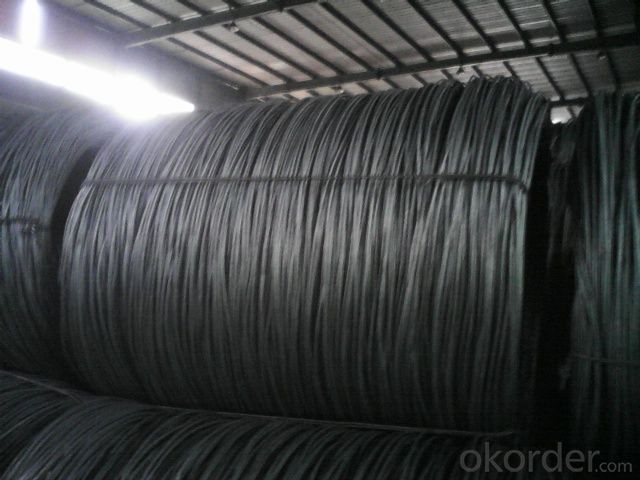
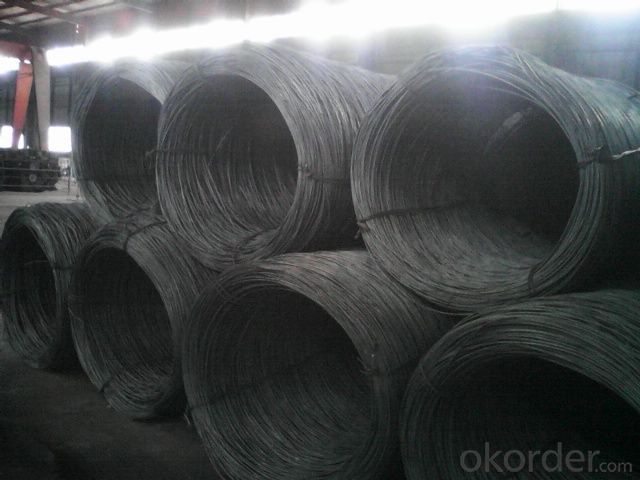
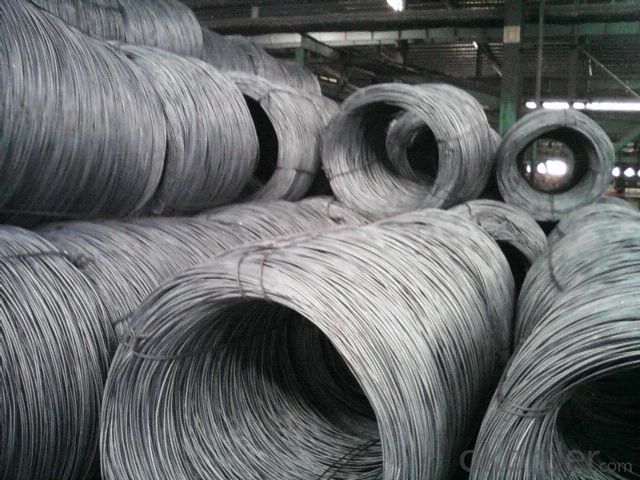
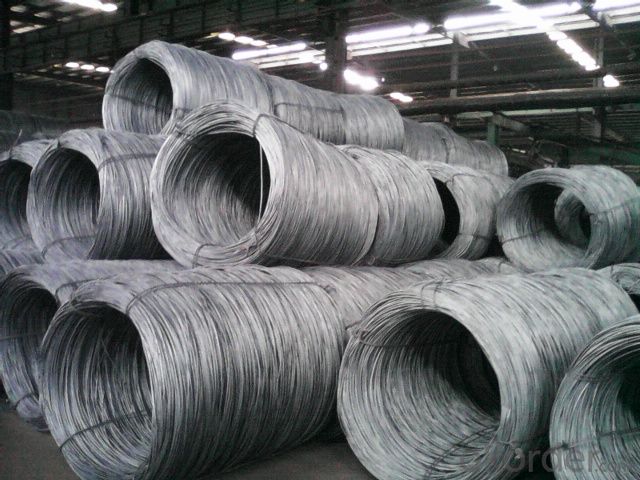
- Q: What are the different types of wire mesh made from steel wire rod?
- There are several different types of wire mesh made from steel wire rod, including welded wire mesh, woven wire mesh, expanded metal mesh, and perforated metal mesh. Each type of mesh has its own unique characteristics and applications. Welded wire mesh is made by welding individual wires together to form a grid pattern, and it is commonly used for fencing, reinforcement, and construction purposes. Woven wire mesh is created by weaving individual wires together in a specific pattern, and it is often used for filtration, screening, and decorative purposes. Expanded metal mesh is produced by cutting and stretching a metal sheet, creating a diamond-shaped pattern, and it is commonly used for grating, walkways, and security applications. Perforated metal mesh is made by punching holes in a metal sheet, and it is often used for filtration, ventilation, and facade applications.
- Q: What are the advantages of using steel wire rod compared to other materials?
- There are several advantages of using steel wire rod compared to other materials. Firstly, steel wire rod offers superior strength and durability. Steel is known for its high tensile strength, which means it can withstand heavy loads and resist deformation. This makes it an ideal material for various applications that require strong and reliable support, such as in construction, manufacturing, and transportation industries. Secondly, steel wire rod has excellent flexibility. Its elasticity allows it to bend and twist without breaking, making it suitable for applications that require dynamic movement or vibrations, such as in suspension systems, springs, and wire ropes. This flexibility also makes it easier to handle and install in various settings. Additionally, steel wire rod is highly resistant to corrosion. It can withstand exposure to moisture, chemicals, and extreme weather conditions without rusting or deteriorating. This resistance to corrosion makes steel wire rod a long-lasting and low-maintenance option, reducing the need for frequent replacements and repairs. Moreover, steel wire rod is readily available and cost-effective. Steel is one of the most commonly used materials worldwide, which means it is readily available in various shapes, sizes, and grades. This availability makes it easy to source and procure steel wire rod, reducing lead times and costs associated with production. Furthermore, steel's recyclability makes it a sustainable and environmentally-friendly choice. Lastly, steel wire rod offers versatility in terms of its applications. It can be used in a wide range of industries and settings, such as in construction, automotive, aerospace, agriculture, and telecommunications. Its adaptability and compatibility with various manufacturing processes make it a go-to material for many engineering and construction projects. In conclusion, the advantages of using steel wire rod compared to other materials include its superior strength, flexibility, corrosion resistance, availability, cost-effectiveness, and versatility. These qualities make steel wire rod a reliable and efficient choice for a wide range of applications.
- Q: How are steel wire rods used in the production of fencing?
- Steel wire rods are used in the production of fencing as they serve as the primary material for creating the wire mesh that forms the structure of the fence. These rods are shaped and woven together to create a durable and secure fencing system that provides protection and containment.
- Q: How are steel wire rods used in the manufacturing of bicycle spokes?
- Steel wire rods are used in the manufacturing of bicycle spokes by being drawn through a series of dies to achieve the desired diameter and strength. These rods are then cut into lengths, threaded at both ends, and attached to the bicycle hub and rim, providing the necessary support and tension to the wheel.
- Q: How is steel wire rod used in the manufacturing of wire rope assemblies for lifting?
- Steel wire rod is an essential component in the manufacturing of wire rope assemblies for lifting. Wire rope assemblies are widely used in various industries for lifting heavy loads, such as in construction, mining, and oil and gas sectors. The steel wire rod serves as the raw material for producing wire ropes, which are composed of multiple strands of steel wires twisted together. These wire ropes are known for their exceptional strength, durability, and flexibility, making them suitable for demanding lifting applications. During the manufacturing process, the steel wire rod goes through several stages. First, the rod is hot rolled to form a long, continuous wire. This wire is then cold-drawn, which reduces its diameter and increases its strength. The cold-drawn wire is further annealed to enhance its ductility and flexibility. After the wire is prepared, it is twisted into strands and then helically laid around a central core, forming the wire rope. The number of strands and the arrangement of wires within each strand can vary depending on the specific requirements of the application. The individual wires within the strands are carefully engineered to distribute the load evenly and maximize the strength of the wire rope. Steel wire rod's properties, such as high tensile strength and excellent resistance to corrosion, play a crucial role in the performance and reliability of wire rope assemblies. The strength of the wire rope allows it to withstand heavy loads, while its corrosion resistance makes it suitable for use in challenging environments, such as marine or offshore applications. In conclusion, steel wire rod is used in the manufacturing of wire rope assemblies for lifting due to its exceptional strength, durability, and corrosion resistance. It serves as the foundation for creating wire ropes that are capable of safely and efficiently lifting heavy loads in various industries.
- Q: How is steel wire rod tested for resistance to pitting corrosion?
- Steel wire rod is tested for resistance to pitting corrosion through various methods such as electrochemical testing, salt spray testing, and exposure to corrosive environments. These tests evaluate the rod's ability to withstand pitting corrosion by measuring factors like its corrosion potential, corrosion rate, and appearance of pits or localized corrosion. Additionally, microscopic examination and surface analysis techniques may be used to further assess the rod's resistance to pitting corrosion.
- Q: What are the different types of steel wire rod surface cleaning methods for wire drawing?
- In the wire drawing process, various methods are commonly employed to clean the surface of steel wire rods. These methods play a vital role in eliminating impurities and ensuring a polished and superior final product. 1. Acid Pickling: Acid pickling is extensively utilized to clean steel wire rod surfaces. This technique involves immersing the wire rod in a solution of hydrochloric acid, which effectively eliminates rust, scale, and oxide layers. By removing surface impurities, acid pickling prepares the wire rod for subsequent wire drawing processes. 2. Electrolytic Cleaning: Another prevalent method for purifying steel wire rod surfaces is electrolytic cleaning. This process entails passing an electric current through the wire rod submerged in an electrolytic solution. The current effectively dissolves and separates contaminants from the wire rod surface. Electrolytic cleaning is especially effective in eliminating oils, greases, and other organic substances. 3. Mechanical Cleaning: Mechanical cleaning involves physically scrubbing and cleaning the wire rod surface using abrasive materials or brushes. This technique can be performed manually or with specialized machinery. Mechanical cleaning is highly efficient in removing stubborn dirt, rust, and scale from the wire rod. 4. Shot Blasting: Shot blasting is a process that involves propelling small metallic or non-metallic particles onto the wire rod surface at high velocities. The impact of these particles effectively eliminates surface contaminants, scale, and rust. Shot blasting is particularly useful for cleaning wire rods with intricate shapes or hard-to-reach areas. 5. Ultrasonic Cleaning: Ultrasonic cleaning employs high-frequency sound waves to generate tiny bubbles in a cleaning solution. These bubbles collapse upon contact with the wire rod surface, creating a scrubbing action that removes contaminants. Ultrasonic cleaning is highly effective in eliminating fine particles, oils, and greases. Each of these steel wire rod surface cleaning methods possesses its own advantages and limitations. The selection of the appropriate method depends on various factors, such as the type of contaminants, wire rod composition, and desired level of cleanliness. Choosing the right cleaning method is crucial to achieve optimal wire drawing performance and produce high-quality wire products.
- Q: How are steel wire rods used in the production of screws and bolts for construction?
- Steel wire rods are an essential component in the production of screws and bolts for construction purposes. These rods serve as the raw material for manufacturing these fasteners. To begin with, steel wire rods are first processed through a series of manufacturing steps. They are initially drawn through a series of dies to reduce their diameter and increase their length. This process is known as wire drawing, and it helps in achieving the desired size and strength of the wire rod. Once the wire rods are drawn to the required dimensions, they are then cut into smaller lengths that are suitable for the production of screws and bolts. These lengths are often referred to as blanks or billets. The next step involves the threading of these blanks to create the screw or bolt shape. This threading process is typically done using specialized machines that cut or roll grooves onto the surface of the wire rods. These grooves are what enable the screws and bolts to effectively grip into their respective materials, providing a secure connection. After the threading process, the blanks are further processed to add various features, such as the head shape, drive type (such as slotted, Phillips, or hex), and any additional coatings or finishes required for corrosion resistance. This is typically done through machining or forging processes, depending on the desired specifications of the screws and bolts. Once the screws and bolts are formed, they undergo quality control checks to ensure that they meet the necessary standards for strength, dimensions, and overall functionality. This includes testing for factors like tensile strength, hardness, and dimensional accuracy. Finally, the screws and bolts are packaged and distributed for use in construction projects. These fasteners play a crucial role in joining various components of a structure together, providing stability, strength, and longevity to the overall construction. They are widely used in applications such as framing, fastening walls, securing beams, and connecting various building materials. In summary, steel wire rods are used in the production of screws and bolts for construction by serving as the raw material that is processed, threaded, and shaped into fasteners with specific features and properties. These fasteners are vital for the structural integrity and reliability of construction projects, making steel wire rods a crucial component in the construction industry.
- Q: What are the different straightening methods for steel wire rod?
- There are several different methods for straightening steel wire rods, including rotary straightening, roll straightening, and stretching straightening.
- Q: What are the different types of wire products that can be made from steel wire rod?
- Some of the different types of wire products that can be made from steel wire rod include steel wire rope, steel wire mesh, steel wire nails, steel wire fences, steel wire baskets, and steel wire hangers.
Send your message to us
Hot Rolled Steel Wire Rod GB/JIS/ASTM/DIN High Qulity
- Loading Port:
- Tianjin
- Payment Terms:
- TT OR LC
- Min Order Qty:
- 500 m.t.
- Supply Capability:
- 30000 m.t./month
OKorder Service Pledge
OKorder Financial Service
Similar products
Hot products
Hot Searches
Related keywords
